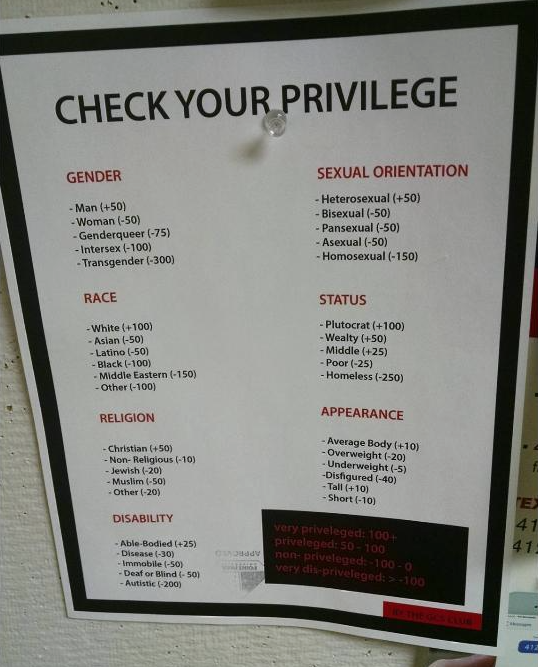This thought-provoking and problematic “check your privilege” list has been circulating on Twitter this morning, seemingly at least partly originating from this tweet.

Normally, I am all for discussions of privilege. These conversations are needed and don’t happen anywhere near often enough. But this chart, goes about it (almost) all wrong.
For starters, it legitimizes that being classified as White, Man, Able-Bodied, etc are good and characteristics to aspire to – you get more “points” after all. The entire “point system” is problematic too because there are no “points,” there is no exact science to discussing and measuring systems of privilege in real, everyday life. Indeed, part of their power is that they can’t be measured. The power of invisibility. Likewise, as we know from Invisible Man, being a minority is to be invisible at times, and this is also problematic.
The point system, as this twitter user suggests, encourages comparisons about who is treated worst. According to this chart: a transgender, Middle Eastern Muslim who is a disfigured, autistic, gay, homeless man is the “least privileged of all.” This is kind of ridiculous. Ridiculous in terms of having an “exact calculation.” Additionally, this privilege list is “racist,” “sexist,” etc., in terms of how it classifies (and doesn’t) such ascribed and achieved statuses.That is to say, this chart implicitly suggests it covers all possible variables, when it doesn’t.
In the humanities, we know that nothing has an exact answer and that there is never any one answer. Given this, I still have questions about these rankings. For instance, I would think that a person being non-reliigous would “cost” him/her more than ten points.
From another perspective, this chart is ambiguous. How “poor” does someone how to be before they are considered “homeless”? What is the difference between being “poor” and being “middle class” given today’s economy? How “tall” is tall? And being a 6′ 6″ individual, sometimes being tall is not a privilege. Also, privilege and discrimination are not static. Gay people have only faced en masse discrimination since around the World War I/World War II era and in ways it is getting worse as (most) Republicans hate gay people and we’re so close to having codified human rights.
Context is important. And this chart ignores context. It also ignores geography (and chronology). Depending on what era, country, state, etc someone lives in the discrimination and “privileges” one receives differ.
This checklist does get credit for recognizing intersectionality. For example, it readily shows that a “White woman” is treated very different than being a “Black woman.” It might help some people realize how good or bad they have it, but it does little else.
Especially meaningful conversations about White Privilege, Heterosexual Privilege, Cisgender Privilege, etc, etc, etc, take an approach like this, this, and/or this. Lists such as these provide direct and indirect solutions, too. White people regularly complain that discussions of privilege are too pointed and oriented toward blame. In reality, discussions of privilege should be focused on being more and more conscious of the world and helping others have better and better opportunities and a happy existence.
What are your thoughts?